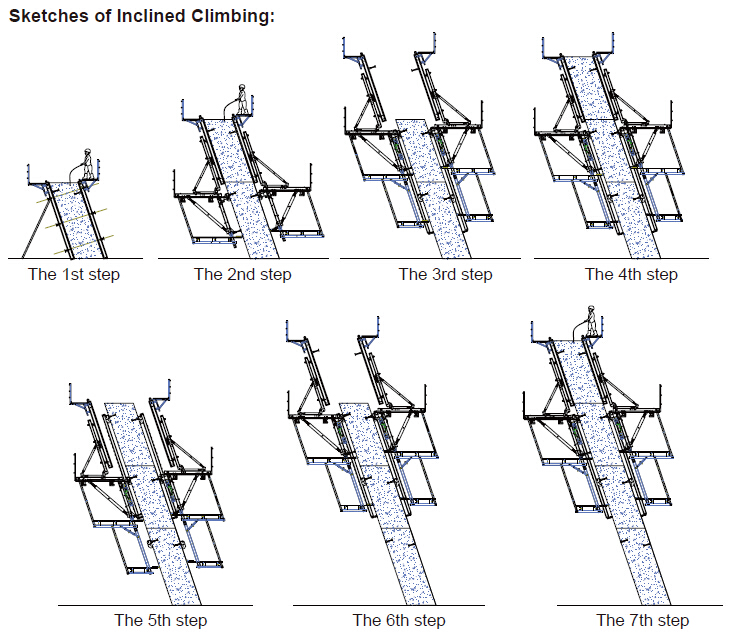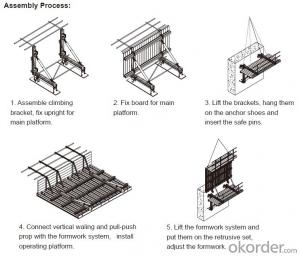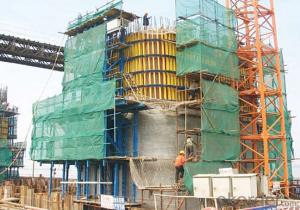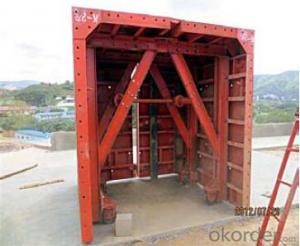Auto Climbing Bracket ACB-100 & ACB-50 for formwork and scaffolding system
- Loading Port:
- Tianjin
- Payment Terms:
- TT OR LC
- Min Order Qty:
- 50 m²
- Supply Capability:
- 1000 m²/month
OKorder Service Pledge
OKorder Financial Service
You Might Also Like
Auto-climbing Bracket ACB100 & ACB50
The power of the auto-climbing formwork is the hydraulic system, which includes the oil cylinder
and two commutators. The commutators can control the climbing of climbing rail and the bracket.
The steel rail and the bracket can inter-climbing, so the whole system will climb up steadily.
Cranes are not needed during the construction. It’s easy to operate, highly efficient and safe. It’s
the best choice for the construction of high buildings and bridges.
There are mainly two types of standard auto-climbing brackets, ACB-50 and ACB-100, the figure
means the push power of cylinder with unit of KN.
Characteristics:
◆ Perfect load bearing anchor system
Anchor system is the most important supporting part. The system is made of five parts shown
below. Thereinto, tensile bolt, V-climbing cone and washer can be taken out for reusing after the
concrete pouring finished.There are two kinds of anchor systems,A & B. A is matched with single
anchor shoe and B is matched with double anchor shoe.
◆ Crane-independent
Crane-independent forming, striking and climbing speeds up the work procedures on the
construction site and also makes them independent of each other. This means the planned
sequences can be maintained along with guaranteeing high productivity levels. The crane can
therefore be used for other tasks.
Hydraulic system is mainly made of two commutators,
oil cylinder and power distribution system.The
commutators can control the climbing of climbing rail
and bracket.
◆ High bearing capacity and safe
The stable working platforms are able to carry large loads, e.g. the storage of reinforcing steel
for the next climbing section. Generously-sized working platforms, the well thought-out design for
handling very high wind loads and the patented control function of the climbing mechanism are
some of the special details contained within the comprehensive safety concept.
◆ Platforms adjusted to suit the angle of inclination
The horizontal working areas thus created provide safe and comfortable conditions for
reinforcement work, shuttering and striking, concreting and finishing.
◆ The ACB formwork system can climb not only vertically but also slantways, the largest angle is
18 degrees.
◆ The system can climb up wholly or separately. The climbing process is steady, synchronous
and safe.
◆ The bracket will not fall to the ground until the construction is finished, the field will be saved
and the impacting breakage will be reduced (especially the panel).
◆ The system will furnish omnidirectional platform, the construction organizations don’t need to
set up additional operation platform.
◆ The error of structure construction is small and easy to correct.
◆ The climbing speed is fast, the construction course will be quickened.
◆ The formwork can climb itself and cleaning work can be done in the same situs , the used times
of tower crane will be greatly reduced.

- Q: What are the different types of form ties used in steel formwork?
- There are several types of form ties used in steel formwork, including wedge bolts, loop ties, taper ties, and she-bolts.
- Q: Can steel formwork be used for theater construction projects?
- Yes, steel formwork can be used for theater construction projects. Steel formwork refers to temporary or permanent molds made of steel that are used to shape and support concrete during the construction process. It is a versatile and durable formwork material that can be used for various construction projects, including theater construction. Steel formwork offers several advantages for theater construction projects. First, it provides a high level of strength and stability, ensuring that the concrete structures built for theaters are sturdy and long-lasting. This is particularly important in theaters, where safety is a top priority due to the large number of people that gather in these spaces. Additionally, steel formwork allows for intricate and complex designs to be achieved, which is often required in theater construction. The flexibility of steel formwork enables the creation of customized shapes, curves, and patterns, allowing architects and designers to bring their creative vision to life. Moreover, steel formwork is reusable, which makes it a cost-effective option for theater construction projects. Unlike traditional wooden formwork that needs to be replaced after a single use, steel formwork can be used multiple times, reducing material and labor costs. Lastly, steel formwork offers a faster construction process. Its ease of assembly and disassembly speeds up the construction timeline, allowing theater projects to be completed in a shorter time frame. In conclusion, steel formwork is a suitable choice for theater construction projects due to its strength, versatility, flexibility, reusability, and efficiency. It offers numerous benefits that contribute to the successful and timely completion of theater construction projects.
- Q: How does steel formwork affect the overall energy efficiency of the structure?
- Steel formwork can have a significant impact on the overall energy efficiency of a structure. One of the main benefits of using steel formwork is its ability to provide a high level of thermal insulation. Steel has a low thermal conductivity, meaning it does not easily transfer heat. This property helps to minimize heat loss or gain through the walls, floors, and ceilings of the structure. By using steel formwork, the building envelope can be better sealed, reducing air infiltration and improving the overall airtightness of the structure. This prevents unwanted air leakage, which can lead to energy loss and reduced energy efficiency. Steel formwork also allows for better control of moisture and humidity levels, which is crucial for maintaining a comfortable indoor environment and preventing mold or moisture-related issues. Additionally, steel formwork provides a durable and long-lasting construction solution. It can withstand extreme weather conditions, seismic activities, and other external forces, ensuring the structural integrity of the building for many years. This durability reduces the need for frequent repairs or replacements, which can save energy and resources in the long run. Furthermore, steel formwork is a sustainable choice as it is often made from recycled materials and is itself recyclable at the end of its lifespan. The use of recycled steel reduces the carbon footprint associated with construction and helps conserve natural resources. The recyclability of steel formwork also means that it can be repurposed or reused in future projects, further reducing waste and environmental impact. In summary, steel formwork positively affects the overall energy efficiency of a structure by providing excellent thermal insulation, improved airtightness, moisture control, durability, and sustainability. By choosing steel formwork, builders can create energy-efficient buildings that are environmentally friendly and cost-effective in the long term.
- Q: How does steel formwork contribute to sustainable construction practices?
- Steel formwork offers several advantages for sustainable construction practices in the following ways: 1. Longevity: The durability of steel formwork allows it to be reused multiple times, thereby reducing the frequency of replacements. This minimizes waste generation during construction and reduces the environmental impact associated with manufacturing new formwork materials. 2. Energy-consciousness: Steel formwork's high strength-to-weight ratio means that less material is required to achieve the same structural support compared to other formwork materials. This results in reduced energy consumption during the manufacturing and transportation of formwork components. 3. Waste minimization: Customizable steel formwork can be tailored to fit project requirements, resulting in minimal waste during construction. Furthermore, the modular design of steel formwork enables easy disassembly and reconfiguration, reducing construction waste and facilitating efficient recycling or reuse of materials. 4. Accelerated construction: Steel formwork systems are designed for swift assembly and disassembly, leading to faster construction times. This reduces project duration, minimizes disruption to the environment, and conserves resources. 5. Heightened safety: The strong and stable support structure provided by steel formwork lowers the risk of accidents or structural failures during construction. This creates a safer working environment for construction workers, promoting sustainable practices by improving worker welfare. 6. Recyclability: Steel is a highly recyclable construction material, and steel formwork can be easily recycled at the end of its useful life. This fosters a circular economy by reducing the demand for new steel production and minimizing the environmental impact associated with mining and extracting raw materials. In conclusion, the durability, energy efficiency, waste reduction, accelerated construction, enhanced safety, and recyclability of steel formwork make it an environmentally sustainable choice for construction practices. By incorporating steel formwork into construction projects, builders can contribute to sustainable development by reducing environmental impacts and promoting resource efficiency.
- Q: I would like to ask, large steel formwork and the average number of square meters of a template?
- Single wage calculation, 9000 flat template assembly line
- Q: How does steel formwork contribute to the overall sustainability of the construction industry?
- Steel formwork contributes to the overall sustainability of the construction industry in several ways. Firstly, steel formwork is highly durable and long-lasting. It can be reused multiple times, reducing the need for new formwork materials for each construction project. This significantly reduces the amount of waste generated during the construction process and minimizes the overall environmental impact of the industry. Additionally, steel formwork is a more sustainable alternative to traditional formwork materials such as timber. Timber formwork often requires cutting down trees, which contributes to deforestation and habitat destruction. By utilizing steel formwork, we can reduce our reliance on timber and help preserve forests. Steel formwork also offers greater structural stability and strength compared to other materials. This allows for more efficient construction processes and reduces the need for additional support structures. As a result, less material is wasted, energy is saved, and the overall construction time is shortened, making the process more sustainable. Furthermore, steel formwork is highly resistant to weather conditions, corrosion, and fire. This ensures the longevity of the buildings, reducing the need for frequent repairs or replacements. By using steel formwork, we can create structures that have a longer lifespan, resulting in reduced resource consumption and waste generation over time. Lastly, steel formwork is recyclable. At the end of its life cycle, steel formwork can be easily melted down and reused for other applications. This reduces the demand for new steel production, conserving natural resources and reducing energy consumption. In conclusion, steel formwork contributes to the overall sustainability of the construction industry by being durable, reusable, resistant to weather conditions, and recyclable. Its use helps minimize waste generation, deforestation, energy consumption, and resource depletion, making it an environmentally-friendly choice for construction projects.
- Q: Can steel formwork be used for both interior and exterior concrete elements?
- Yes, steel formwork can be used for both interior and exterior concrete elements. Steel formwork is highly versatile and can be used in various construction applications. It is durable, strong, and capable of withstanding the pressure exerted by the wet concrete. Additionally, steel formwork offers excellent dimensional accuracy and can create smooth and uniform concrete surfaces. Whether it is for interior slabs, walls, or exterior foundations, columns, or beams, steel formwork is a reliable choice that can be used for both interior and exterior concrete elements.
- Q: What are the common accessories used with steel formwork?
- Some common accessories used with steel formwork include form ties, wedges, form release agents, formwork clamps, and form liners. Form ties are used to hold the formwork together and ensure that it remains in place during concrete pouring and curing. They are typically made of steel and are available in various lengths and designs to suit different formwork requirements. Wedges are used in conjunction with form ties to secure the formwork tightly. They are typically made of steel or plastic and are inserted into the form tie to secure it firmly. Form release agents are applied to the formwork surface to prevent the concrete from sticking to the formwork. They create a barrier between the concrete and the formwork, making it easier to remove the formwork after the concrete has cured. Formwork clamps are used to hold the formwork panels together and ensure that they remain aligned and in place during concrete pouring. They are typically made of steel and come in various sizes and designs to suit different formwork systems. Form liners are used to create decorative patterns or textures on the surface of the concrete. They are typically made of plastic or elastomeric materials and are attached to the formwork before concrete pouring. Once the concrete has cured, the form liners are removed, leaving behind the desired pattern or texture on the concrete surface. These accessories are commonly used with steel formwork systems to enhance the efficiency and effectiveness of the formwork process and ensure high-quality concrete construction.
- Q: How does steel formwork handle different concrete surface slip resistance?
- Steel formwork, a versatile and robust material commonly used in construction, is essential for shaping and supporting concrete during the curing process. In terms of managing slip resistance on concrete surfaces, steel formwork offers numerous benefits. Firstly, steel formwork guarantees a smooth and uniform surface for pouring concrete, minimizing variations in slip resistance. Unlike materials like wood, steel does not warp or deform, ensuring consistent contact between the formwork and concrete. This uniformity promotes a more consistent concrete surface, reducing the risk of uneven slip resistance. Furthermore, steel formwork allows for the utilization of different surface treatments and coatings that can enhance slip resistance. For example, before pouring the concrete, anti-slip coatings or aggregates can be applied to the formwork surface, creating a textured surface that improves traction. These treatments can be customized to meet specific requirements for slip resistance, providing design flexibility. Moreover, steel formwork is extremely durable and resistant to wear and tear. This durability ensures that the formwork maintains its structural integrity throughout the concrete pouring process, minimizing the occurrence of surface irregularities that could affect slip resistance. Additionally, steel formwork is easy to clean and maintain, ensuring that any contaminants or debris that could impact slip resistance are promptly addressed. In conclusion, steel formwork effectively manages different levels of slip resistance on concrete surfaces by providing a smooth and consistent surface, allowing for customization through various treatments, and maintaining durability to prevent surface irregularities. Its strength and versatility make steel formwork a dependable choice for construction projects where slip resistance is a concern.
- Q: Can steel formwork be used for precast concrete walls?
- Precast concrete walls can indeed utilize steel formwork. Steel formwork is widely employed in the construction industry due to its robustness, longevity, and reusability. It furnishes a stable and sturdy structure for the casting and molding of concrete during the manufacturing process of precast concrete walls. The utilization of steel formwork is appropriate for precast concrete walls because it can endure the pressure exerted by the wet concrete without bending or distorting. It guarantees that the concrete is poured and solidified in the desired shape and dimensions. Additionally, steel formwork can be effortlessly assembled and disassembled, enabling efficient and cost-effective production of precast concrete walls. An added benefit of employing steel formwork for precast concrete walls is its ability to generate smooth finishes. The steel panels or molds can be fashioned to create diverse textures and patterns on the final wall surface. This adaptability allows for increased design options and aesthetic appeal in the end product. Furthermore, steel formwork can be reused numerous times, making it an environmentally friendly and economical choice for precast concrete wall production. The durability of steel ensures that it can withstand the repetitive strains of the manufacturing process without significant deterioration. To summarize, due to its strength, durability, reusability, and capacity to produce smooth finishes, steel formwork is a suitable material for precast concrete walls. It establishes a solid framework for the molding and casting of concrete, permitting efficient and cost-effective production of precast concrete walls.
Send your message to us
Auto Climbing Bracket ACB-100 & ACB-50 for formwork and scaffolding system
- Loading Port:
- Tianjin
- Payment Terms:
- TT OR LC
- Min Order Qty:
- 50 m²
- Supply Capability:
- 1000 m²/month
OKorder Service Pledge
OKorder Financial Service
Similar products
Hot products
Hot Searches


















